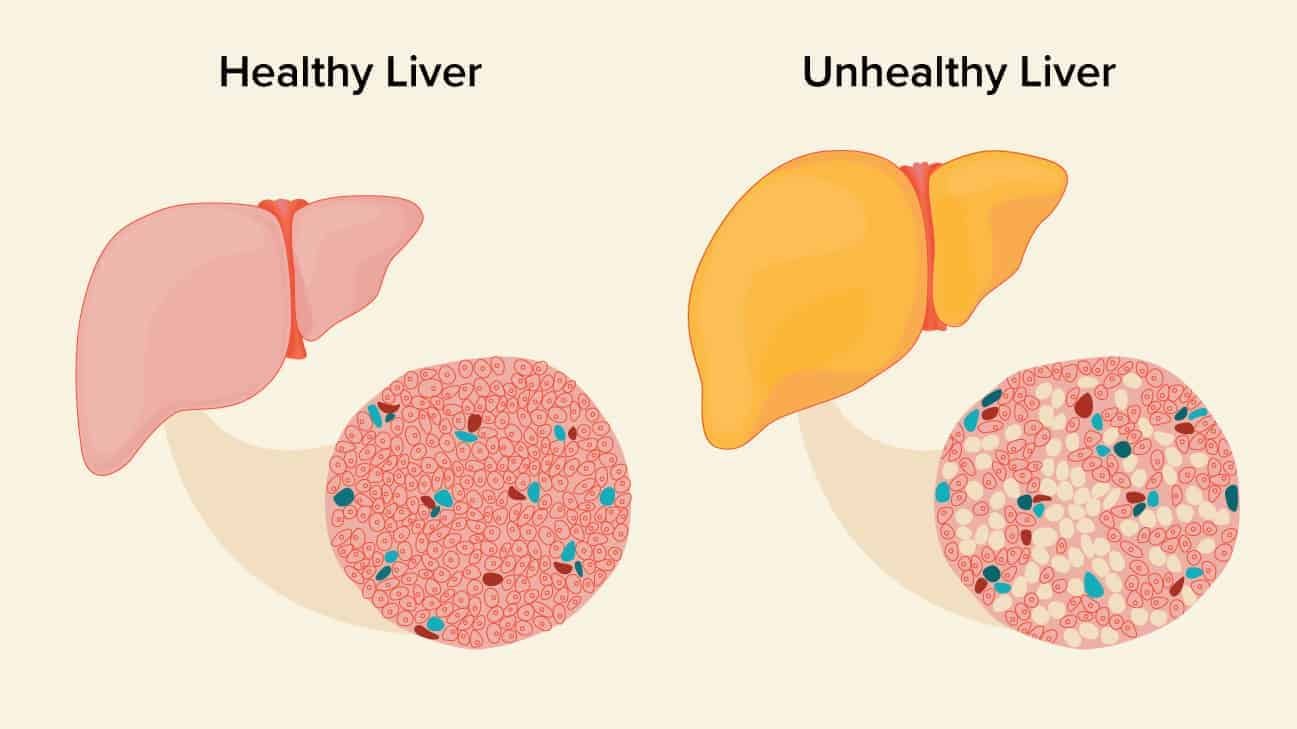If you are healthy and have been diagnosed with NAFLD, otherwise known as Nonalcoholic Fatty Liver Disease, you are probably asking yourself why this has happened to you.
Actually, a lot of healthy people develop Fatty Liver Disease and like you, ask themselves this question: Why me?
To those who feel reasonably well and believe themselves to be in good health, finding out that there is something wrong with their liver is terribly unfair. You might wonder how you could have a health problem like this and not feel sick. Or, worse yet, your neighbor has poor eating habits and doesn’t exercise, and is completely healthy.
So, what causes people who feel more or less healthy to have a fatty liver?
Causes of Nonalcoholic Fatty Liver Disease
There are factors that can predispose you to developing Fatty Liver Disease. In many cases, even if you are living a healthy lifestyle now, you may have had certain behaviors in the past or been exposed to various substances or diseases that have caused you to develop Fatty Liver disease now.
Here are some of the factors that might cause you to have Nonalcoholic Fatty Liver Disease:
- Genetics – If you’re Hispanic, you are unfortunately predisposed to fatty liver disease. There is strong evidence linking a certain gene (PNPLA3) to higher instances of liver problems. There are other genetic conditions, too, that can bring about liver disease.
- Poor Nutrition and Starvation – Not eating a healthy diet or enough food in general can cause you to develop liver disease. So, even if you are conscientious now about observing healthy eating habits, if you binge dieted in the past or were anorexic and/or bulimic, you might develop Nonalcoholic Fatty Liver Disease later in life.If you went on a crash diet recently, your body’s “starvation mode” can trigger the disease as well, since your liver thinks a famine is happening, and accumulates more fat when you don’t eat enough. (Remember, our bodies are designed to live in a constant famine/plenty environment, not a life of constant “plenty” as we’ve been experiencing for the past century.)
- Certain Medications – There are quite a few medications, both over the counter, and prescription drugs, that can cause you to develop Fatty Liver Disease. Tylenol and Aspirin are known causes, if overdosed. (Basically, your liver can’t fully break down the ingredients if you take over the recommended dosage, causing toxic damage – this is why infants must not take Aspirin.)Other drugs include those used to treat HIV, depression, cancer and other diseases. Corticosteroids may also be involved in developing liver problems.
- Environmental Toxins – Nonalcoholic Fatty Liver Disease has been identified in persons who were exposed to certain environmental chemical toxins such as petrochemicals and phosphorus poisoning.
- History of Alcohol Abuse – If you have consumed too much alcohol in the past, it can cause you to have liver disease even years after you stopped drinking. So, if you drank heavily in your younger days, Nonalcoholic Fatty Liver Disease could come back to bite you in the future.
- Blood Transfusion – If you had a blood transfusion or organ transplant prior to May of 1990, it is possible that you may have contracted the Hepatitis virus, which can cause NAFLD. Until then, blood for transfusions, including donated blood, was not screened for Hepatitis.
- Shared Needles – People with a history of recreational drug use that shared needles may develop liver disease much later on in life. Ditto for those who have gotten tattoos that were done with unsterilized needles that transferred Hepatitis or HIV from person to person.
Like other notorious conditions, non-alcoholic fatty liver disease (NAFLD) is frequently referred to as “silent.”

That’s because as with pre-diabetes, hypertension, skin cancer/melanoma and osteoporosis, NAFLD may sneak up on you – or appear to.
The truth is, though, nobody simply wakes up with NAFLD. As with many of the cases above, by the time you know you have NAFLD you may have been developing the condition for years or even decades, experts say.
How does it happen? Unfortunately, NAFLD may be entirely symptomless, and even when it isn’t, the aches and pains may be general or could be put down to a different condition – sometimes even by doctors, experts warn.
In addition, despite its increasing presence (between 20 and 30% of all adults in the U.S. currently according to the National Institutes of Health), most people don’t know the signs of NAFLD.
Indeed, the suggestion that NAFLD may be a concern is generally met with surprise and denial, according to experts in the disease.
Here are five myths about non-alcoholic fatty liver disease, and why you may want to think twice about whether you’re at risk.
MYTH #1: “I can’t have NAFLD because I’m not overweight.”
While it’s true that too high a BMI is an indicator that NAFLD could become an issue later in life, simply being overweight is no guarantee that you’ll get the disease – and on the opposite side of things, being slender doesn’t mean you won’t get it, doctors say.
Indeed, Eastern medical professionals have advised the NIH that in studies, up to 15% of non-overweight individuals were found to have NAFLD.
The mechanism isn’t clear, but it could be the type of one’s diet rather than the overall calories that are a factor.
This means even if you’re lean, you should take a second look at your diet and be sure you’re including plenty of lean protein sources, dairy sources unless you have an intolerance, and above all, veggies and controlled portions of fruit. (NOTE: If you have dietary restrictions, are taking certain medicines or have a chronic or acute condition, you may need a diet specific to you. Ask your doctor.)
MYTH #2: “I can’t have NAFLD because I walk every other day. None of my friends do; I have a jump on prevention.”
As with diet and weight, exercise figures into the development of NAFLD; a good exercise regimen appears to help stave off the condition in a number of individuals.
However, exercise alone can’t keep NAFLD from appearing in your body, nor prevent the damage the condition may do over time.
Recommended exercise for otherwise healthy adults is 30 minutes of vigorous walking every day when possible plus 20 minutes of light to heavy weights two to three times a week. This is in conjunction with maintaining a healthy weight and a healthy diet, according to researchers.
MYTH #3: “I can’t have NAFLD because my upper abdomen doesn’t hurt.”
Experts believe the myth that NAFLD is always accompanied by pain in the upper right quadrant of the abdomen is because of a small percentage of sufferers experiencing such pain before diagnosis. The idea is that if there isn’t any pain, there can’t be any NAFLD.
But this just isn’t so, according to doctors specializing in the disease.
The condition CAN be accompanied by pain anywhere in the abdomen, particularly but not exclusively the upper right-hand side, but it may appear with no pain at all, only showing up when other tests are ordered and a larger, fattier than normal liver is spotted.

Don’t wait until you have pain to get a checkup, and if you do have pain anywhere in your abdomen, don’t wait – see your doctor immediately or if she’s unavailable, go the emergency room or Urgent Care. Your issue may be something else entirely. Abdominal pain is never a thing to be ignored.
MYTH #4: “I can’t have NAFLD because my parents never had it.”
Don’t be so sure. Here are three points to consider:
- Your parents may have had NAFLD but died from something else, or they may currently be living but have NAFLD silently. In the past, the condition was missed far more frequently than it is today.
- Today’s Western diet is more highly refined, sugar- and fat-laden and contains far more fast foods and restaurant prepped meals than at any other time in history, making your risk for developing fat in any part of the body, including in and around the liver, higher than in the past even when allowing for genetics.
- A family history is always important when discussing any medical issue with your doctor, but metabolic and weight-related diseases are at an all-time high despite family history, so don’t feel immune. Ask your doctor for tests, get your weight under control and exercise regularly.
MYTH #5: “I can’t have NAFLD because I’m a woman.”
Men have long taken the bad rap in fatty liver disease just as they have with other issues such as snoring or heart attack. But with weight gain and underexercising on the rise for both sexes, women are not immune from the condition, according to medical professionals.
ANYONE can develop NAFLD given the conditions that support it.
MYTH #6: “I can’t have NAFLD because I’m young.”
Sadly, as obesity, Type II diabetes and metabolic syndrome are rising in people under the age of 18, so is NAFLD.
In fact, pediatricians warn NAFLD is the MOST common liver issue found in children. And as with adults, it’s on the rise.
That means that if you think your child can’t possibly have the condition, or if you are in your 20s or early 30s and feel immune, think again, medical professionals warn.
If you suspect NAFLD, take measures now – don’t wait for the condition to silently grow and worsen as the years go by.
MYTH #7: “I don’t live in the U.S. My chances of having this issue are much lower.”
The U.S. is used to being the metabolic and weight bogeyman of the globe, but sadly, other nations are catching up on issues of obesity and conditions related to obesity, experts warn.
In particular, England, Ireland and Canada appear to be playing catchup when it comes to a total number of obese adults and, frighteningly, obese children as well.
Along with this change, more fatty liver is being seen around the globe, not just in the U.S.
The issue may be as much one of the quality of one’s diet as the quantity, and first world nations in general eat far more refined, fatty, sugary foods than in the past (and compared to some other countries).
The truth is that anyone can develop NAFLD. Particularly if you have warning factors, such as metabolic syndrome, Type II diabetes, are overweight, don’t get enough exercise or if obesity runs in your family, keep an eye out on your health and put things in check before they get out of hand. If you do, you can beat the odds and live a healthy and long life, so don’t worry and don’t deny; be aware and be well.
So, you can see that as unfair as it might seem, you can have Nonalcoholic Fatty Liver Disease now that was caused by past lifestyle factors. However, even a blood transfusion or organ transplant, exposure to environmental toxins, medications, a history of poor nutrition in the past, or even heredity can be causes.
The main thing is, if you have been diagnosed with Nonalcoholic Fatty Liver Disease, to begin taking action immediately to reverse it and restore your liver to a state of good health.
Take Our Trusted Course

Frequently Asked Questions
[sc_fs_faq html=”true” headline=”h2″ img=”” question=”What Are Causes of Nonalcoholic Fatty Liver Disease?” img_alt=”” css_class=””] Genetics; Poor Nutrition and Starvation; Certain Medications; Environmental Toxins; History of Alcohol Abuse; Blood Transfusion; Shared Needles [/sc_fs_faq]
Originally posted 2019-07-07 10:46:36.



